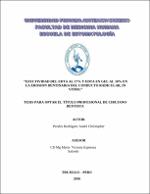| dc.contributor.advisor | Espinoza Salcedo, María Victoria | |
| dc.contributor.author | Perales Rodríguez, André Christopher | |
| dc.creator | Perales Rodríguez, André Christopher | |
| dc.date.accessioned | 2016-09-07T17:02:19Z | |
| dc.date.available | 2016-09-07T17:02:19Z | |
| dc.date.issued | 2016 | |
| dc.identifier.uri | https://hdl.handle.net/20.500.12759/1840 | |
| dc.description.abstract | El propósito del presente estudio fue determinar la diferencia de la efectividad del EDTA al 17% y EDTA en gel al 10%, en la erosión dentinaria del conducto radicular, in vitro. El estudio estuvo constituido por una muestra de 46 premolares unirradiculares; los cuales fueron seleccionados a través de un método no probabilístico, por conveniencia. Los dientes fueron instrumentados e irrigados con hipoclorito al 4.25% y como irrigación final EDTA al 17% y EDTA al 10 % en gel respectivamente luego lavados con suero fisiológico. Posteriormente los dientes fueron cortados de forma longitudinal y luego observados en el microscopio electrónico los tercios medio y apical los cuales fueron valorados por los criterios de Torabinejad.
Se empleó la prueba no paramétrica de independencia de criterios utilizando la distribución chi cuadrado o prueba exacta de Fisher con un nivel de significancia del 5% (p < 0.05).
Se concluyò que existe diferencia estadísticamente significativa al comparar la efectividad de erosión en el tercio medio del EDTA al 17% vs el EDTA gel al 10% mas no existe diferencia estadísticamente significativa al comparar la efectividad de erosión en los tercios apicales entre cada producto. | es_PE |
| dc.description.abstract | The purpose of this study was to determine the difference in effectiveness of 17% EDTA and
EDTA gel 10% in root canal dentin erosion in vitro. The study consisted of a sample of 46
single-rooted premolars; which they were selected through a non-probabilistic method, for
convenience. The teeth were instrumented, irrigated with 4.25% hypochlorite and final
irrigation 17% EDTA and 10% EDTA gel in respectively then washed with saline.
Subsequently the teeth were longitudinally cut into shapes and then observed under the
electron microscope the middle and apical thirds of which were valued by Torabinejad
criteria.
nonparametric test of independence criteria was employed using the chi-squared distribution
or Fisher's exact test with a significance level of 5% (p <0.05).
Thus it concluded that there is statistically significant difference when comparing the
effectiveness of erosion in the middle third of EDTA 17% vs 10% EDTA gel but there is no
statistically significant difference when comparing the effectiveness of erosion in the apical
thirds difference between each difference. | en_US |
| dc.description.uri | Tesis | es_PE |
| dc.format | application/pdf | es_PE |
| dc.language.iso | spa | es_PE |
| dc.publisher | Universidad Privada Antenor Orrego | es_PE |
| dc.rights | info:eu-repo/semantics/openAccess | es_PE |
| dc.rights.uri | https://creativecommons.org/licenses/by/4.0/ | es_PE |
| dc.source | Universidad Privada Antenor Orrego | es_PE |
| dc.source | Repositorio Institucional - UPAO | es_PE |
| dc.subject | Erosión dentinaria | es_PE |
| dc.subject | EDTA al 17 % | es_PE |
| dc.subject | EDTA gel 10% | es_PE |
| dc.title | Efectividad del EDTA al 17% y EDTA en gel al 10% en la erosión destinaria del conducto radicular, in vitro | es_PE |
| dc.type | info:eu-repo/semantics/bachelorThesis | es_PE |
| thesis.degree.level | Título Profesional | es_PE |
| thesis.degree.grantor | Universidad Privada Antenor Orrego. Facultad de Medicina Humana | es_PE |
| thesis.degree.name | Cirujano Dentista | es_PE |
| thesis.degree.discipline | Estomatología | es_PE |
| dc.subject.ocde | https://purl.org/pe-repo/ocde/ford#3.02.14 | es_PE |
| renati.type | https://purl.org/pe-repo/renati/type#tesis | es_PE |
| renati.level | https://purl.org/pe-repo/renati/level#tituloProfesional | es_PE |
| renati.discipline | 911016 | es_PE |
| dc.publisher.country | PE | es_PE |


